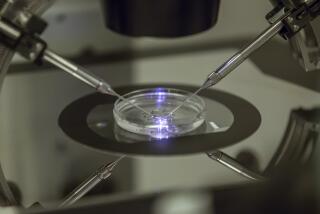Fertile Territory
- Share via
In vitro fertilization fails to produce a baby for about 75% of the couples who attempt it. Reasons range from poor embryo quality and quantity to implantation problems to bad luck. But oftentimes, doctors simply cannot explain the failure.
Now, however, a study of women who use donor eggs when undergoing IVF points to what is possibly the most significant factor related to female infertility: the quality of the eggs.
An analysis of 276 patients at USC showed that 87.9% of the women became pregnant after one to four attempts, or cycles, at IVF using donor oocytes (the medical term for eggs). That is about triple the success rate for many women who use their own eggs, the researchers said.
Moreover, Dr. Richard Paulson, who led the study, said that a woman’s chance of having a baby using donor eggs did not depend on her age or her particular infertility diagnosis.
The women in the study opted for the use of donor eggs for various reasons that included menopause, the wish to avoid passing on an inherited disease to their offspring or sterility caused by chemotherapy. Seventy of the women had been unsuccessful at repeated IVF attempts using their own eggs.
During IVF, sperm is mixed with eggs to produce embryos. Healthy embryos are then transferred to the uterus.
Paulson’s analysis strongly implies that healthy young eggs are the crucial ingredient to establishing pregnancy--not the condition of the gestational mother’s endometrium (the lining of the uterus) or factors related to implantation of the embryo.
“This paper drives home the point that it’s the egg, not the uterus, that is most important. And age does not seem to be an issue,” said Dr. David Guzick of the Rochester School of Medicine in Rochester, N.Y., who has conducted similar research on cumulative IVF success rates.
When a woman fails to become pregnant using her own eggs in IVF, one of two problems is usually suspected, Paulson said.
“It is either a problem of embryo quality--which is related to egg or sperm quality--or it is a problem with the endometrium. But sometimes you don’t know which factor is creating the problem. By having one [the egg] come from one woman and the other [the endometrium] come from the other woman, you can separate the factors,” he said.
While a single cycle of IVF produces a baby in about 24.5% of all women under 40, Paulson found a single-cycle delivery rate of 29.3% in women using donated eggs. Paulson’s cumulative success rate after four cycles of IVF with donor eggs was 86.1%. The success rates were calculated only for fresh embryos. Frozen-thawed embryos were not included in the analysis.
If the condition of the woman’s endometrium played a significant role in establishing pregnancy, one would expect those women with the healthiest uterine lining--termed endometrial receptivity--to become pregnant first and the remaining groups to have progressively decreasing success rates. But that is not the case, Paulson said.
The study has two messages, he said: One primarily for infertile women and one for infertility specialists. For women: “I’m hoping the lesson is that no matter how many cycles in which you have failure, egg donation will be able to level the playing field. I think a lot of people are not aware of that.”
For clinicians in the ever-changing field of assisted reproductive technology, the analysis suggests that techniques to improve endometrial receptivity and implantation in IVF may have limited promise. In recent years, solving the mystery of why some embryos attach to the uterus to produce a pregnancy and some do not has generated several theories--and practices to correct the problems.
Among them is the widely held belief that a woman’s own body can produce antibodies that attack the embryo and prevent it from implanting. Treatment called immunotherapy to try to reverse that rejection has become popular for women who experience repeated IVF failure.
“Immunotherapy is trying to cure an intrinsic defect in endometrial receptivity. I think our paper presents very serious doubt upon that theory,” Paulson said. “I think this is very strong evidence that [repeated IVF failure] is an egg-quality issue that cannot be addressed by immunotherapy. Our paper does not rule it out. But it makes it improbable [that immunotherapy plays a significant role].”
Much more research is needed to understand what accounts for persistent infertility in some women who are trying to use their own eggs, said Dr. Carolyn Coulam of the Center for Human Reproduction in Chicago. Nevertheless, she said, Paulson’s paper should lead doctors to think more carefully about egg quality.
“Clearly, a higher proportion of IVF failure than we previously thought is due to egg problems,” she said. “So this is good new information. It tells us to keep going instead of looking for other factors [that might account for failure.]”
Some women, however, do have problems with implantation of the embryo, Coulam said.
“This doesn’t mean that infertile women don’t have a contributing factor of intrauterine receptivity. It does tell us that, in a higher proportion of women, the eggs are contributing to implantation failures. But we don’t have the tools yet to tell what proportion is due to implantation failure and what proportion is due to egg failures,” she said.
The paper also casts doubt on the idea that embryos that look healthy and are dividing properly in vitro are healthy. Embryos that look good and are dividing appropriately just prior to being transferred to the uterus are thought to offer the best chance of implantation. But both human and animal studies suggest that looks can be deceiving. One study of mouse embryos that were exposed to a toxic substance showed that the embryos grew at a healthy rate but failed at a later stage of development.
“It may very well be that these [egg] defects show themselves later on,” Paulson said.
The fact that IVF with egg donation produces a consistently high chance of success for almost every woman may give more infertile couples reason to consider this option earlier in the course of their infertility treatment.
But a woman’s decision to relinquish the chance at having a baby that is her genetic offspring is a difficult one for many.
“I sit down with couples, with the woman in her early 40s, and I have to tell her that oocyte donation has threefold greater chance of success [than using her own eggs],” Paulson said. “But egg donation means the woman does not get to participate genetically. It’s like comparing apples and oranges. You have to be ready to say, ‘I just want a fruit.’ ”
(BEGIN TEXT OF INFOBOX / INFOGRAPHIC)
Pregnancy Attempt Success Rate
Women who undergo in vitro fertilization using donor eggs have a high likelihood of success, no matter what the patient’s age or infertility diagnosis. The chances of getting pregnant increase with each subsequent IVF attempt, according to new research.
Source: Dr. Richard Paulson, USC






